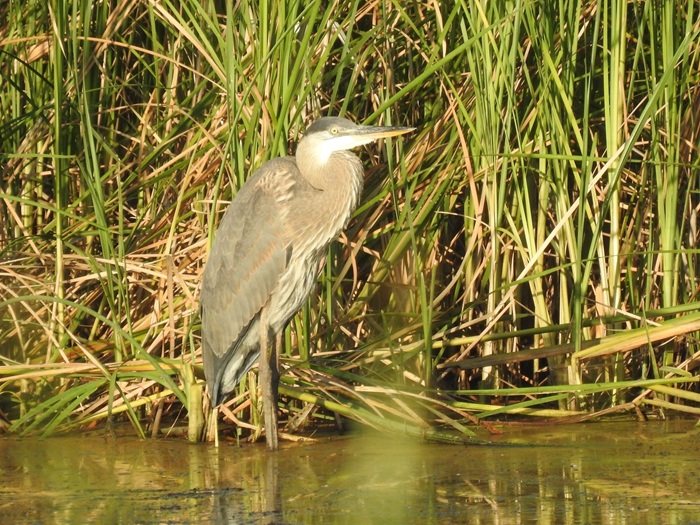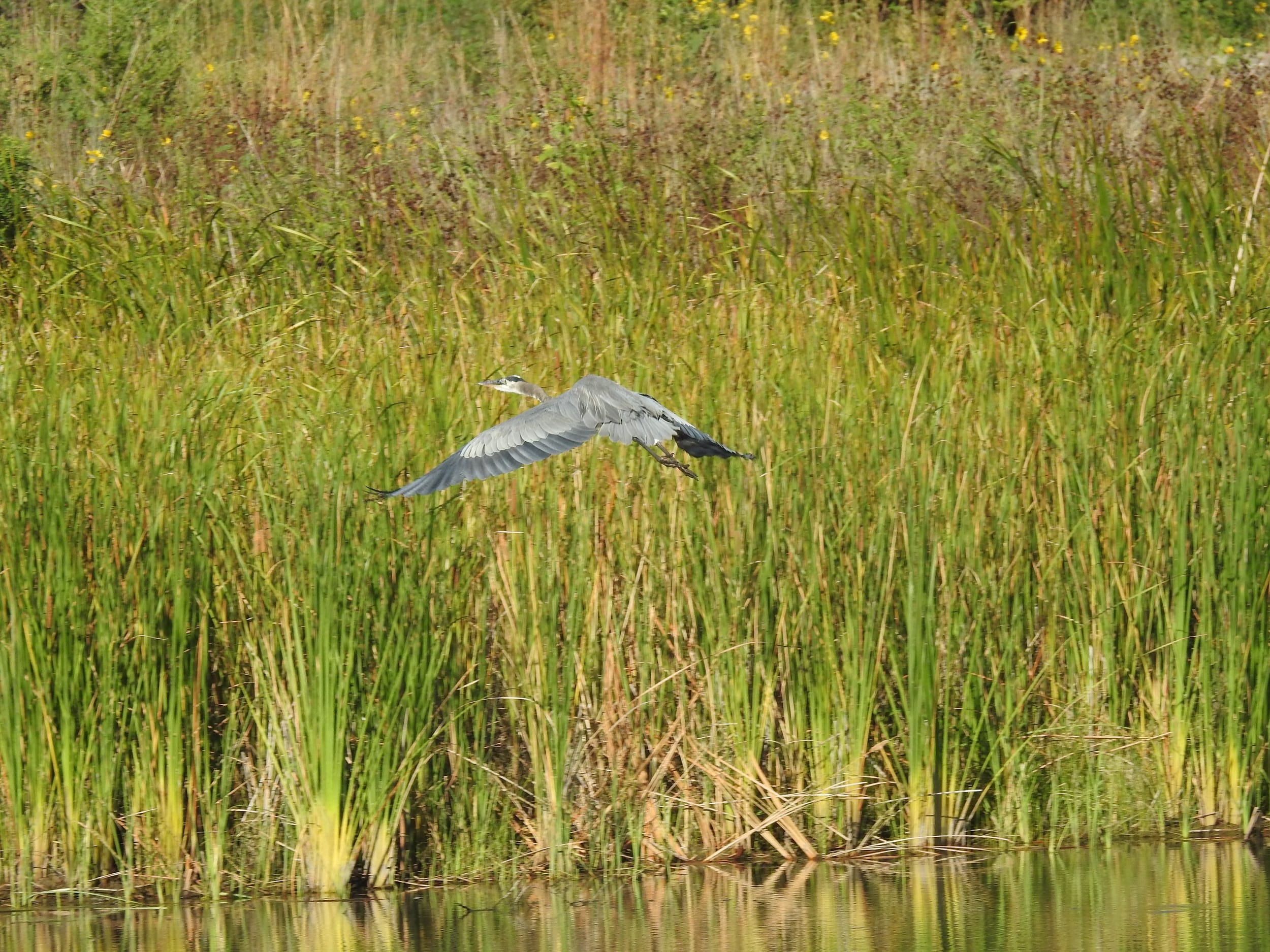A Closer Look at Great Blue Heron Habits
Appearance: Size, Field Marks
The Great blue heron, scientifically known as Ardea herodias, is a bird of the wetlands known for large size and remarkable hunting skills.
With its long legs and neck, it wades through shallow waters, while its wingspan can reach an impressive 6 feet (1.8 meters).
This Heron has a blue-gray plumage, white face, and a distinctive black stripe extending from its eye to the back of its head.

Its long, yellowish beak is adapted for snatching fish and other small creatures which form most of its diet.
During the April - May breeding season, both male and female great blue herons undergo a transformation.
Delicate plumes grace their heads, necks, and backs, serving as displays to attract potential mates.
While males and females share similar appearances, the males tend to be slightly larger, although discerning this difference without a side-by-side comparison can be challenging.
Feeding Habits
Great blue herons are skilled hunters. Their primary diet consists of fish, but it also eats amphibians, reptiles, small mammals, insects, and sometimes even birds.
To find food, the heron uses a stealthy approach. It typically hunts in shallow freshwater habitats like marshes, swamps, and the edges of lakes or rivers.
Standing motionless or moving slowly, the heron uses its sharp eyesight to spot prey beneath the water's surface.
When it spots a potential meal, the great blue heron strikes with remarkable speed and precision.
It extends its long neck and thrusts its sharp beak into the water, impaling the prey with its strong bill.
The heron's neck is specially adapted to coil and extend rapidly, allowing it to strike fast with accuracy.
Its long legs and sharp claws aid in capturing and holding onto slippery prey.
It may also use its wings to create shade or disturb the water, making it easier to spot and catch fish.
Mating and Courtship Behaviors
The courtship rituals of the great blue heron begin with the males selecting a nesting territory, where they engage in a series of displays.
Stretching their necks, flapping their wings, and emitting resonant calls, they seek to attract females.
In response, interested females join in the dance, showcasing their own displays, including neck stretching, feather preening, and bill clacking.
Once a pair bond is established, the male Great-blue Heron collects nesting materials to offer to the female.
The breeding season and egg laying begins in March to Late April depending on location.
While they do have strong seasonal bonds, Great Blue Herons do not mate for life.
Nest Building
These birds construct their nests using specific materials and typically build them in tall trees or on platforms near water.
Often, choosing a territory that has an established colony where multiple pairs of herons nest close to each other.
As part of the courtship ritual, the male presents the gathered materials to the female.
The female then takes on the responsibility of constructing the nest, using the materials provided by the male.
She weaves and arranges the sticks into a sturdy platform, creating a shallow bowl-shaped structure.
To make the nest more comfortable, the female may also incorporate softer materials like grass, moss, leaves, and even feathers.
Over the years, the great blue heron's nest can grow in size as the pair returns to the same nesting site and adds more materials each breeding season.
Some nests can reach impressive dimensions, measuring several feet in diameter and weighing hundreds of pounds.
By building their nests high in trees or on platforms, the herons protect their eggs and chicks from predators like raccoons and snakes.
The elevated position also provides a clear view of the surrounding area, allowing the herons to monitor their territory and spot potential threats.
Nesting Habits, Eggs, Incubation
After nest construction, the female Great Blue Heron lays a clutch of 2-6 pale blue eggs a few days apart.
This staggering of egg-laying ensures that the chicks will hatch at different times, reducing competition for food within the nest.
Both the male and female heron take turns incubating the eggs for about 25-30 days.
Once the eggs hatch, the parents continue to provide care and protection to the nestlings, who emerge from the eggs covered in a soft, downy plumage.
The parents feed the nestlings by regurgitating partially digested food into their mouths, primarily consisting of small fish and other aquatic prey.
As the nestlings grow, they become more active and engage in sibling competition for food and position within the nest.
The parents continue to care for and feed the nestlings until they are ready to fledge, which occurs around 50-60 days after hatching.
| Great Blue Heron Nesting Habits | |
|---|---|
| Eggs | 2 - 6 |
| Incubation | 25 - 30 days |
| Nestling Phase | 50- 60 days |
| Broods | 1 |
Once the nestlings are ready to leave the nest, they practice short flights known as branching, strengthening their flight muscles and coordination.
Habitat: Where You'll Find Them
These birds are highly adaptable and can be found in a variety of habitats across North America. Preferring wetland environments, where they can find food and nesting sites.
Wetlands are a common habitat, including marshes, swamps, and estuaries. These areas provide a diverse range of prey, including fish, amphibians, and invertebrates.

They can also be found around lakes and ponds, especially those with shallow water and ample vegetation.
These habitats provide an ideal hunting ground for the herons, as they can wade through the water and use their sharp beaks to catch fish and other aquatic prey.
Rivers and streams are another habitat where great blue herons can be found, particularly in areas with slow-moving or calm waters.
The herons may perch on rocks or branches near the water's edge, waiting for prey to pass by.
Coastal areas such as salt marshes, mudflats, and tidal creeks are also known to host great blue herons.
These provide a rich food supply, including fish, crabs, and other marine organisms.
Migration Habits
Great blue herons are mostly migratory birds, but some populations are non-migratory.
>As the breeding season ends and winter approaches, those that breed in the northern parts of North America migrate southward to warmer areas for the winter.
Some populations migrate as far south as Central and South America, while others may only travel a few hundred miles to the southern parts of the United States.
The timing and distance of their migration may vary depending on the availability of food and weather conditions.
Surviving Winter
During the winter months, great blue herons survive by adapting to their surroundings.
They may change their diet to include more small mammals and amphibians, as fish may be less abundant in the winter.
They may also roost in groups to conserve body heat and protect themselves from predators.
In addition, they may seek out areas with warmer water temperatures, such as hot springs or geothermal vents.






